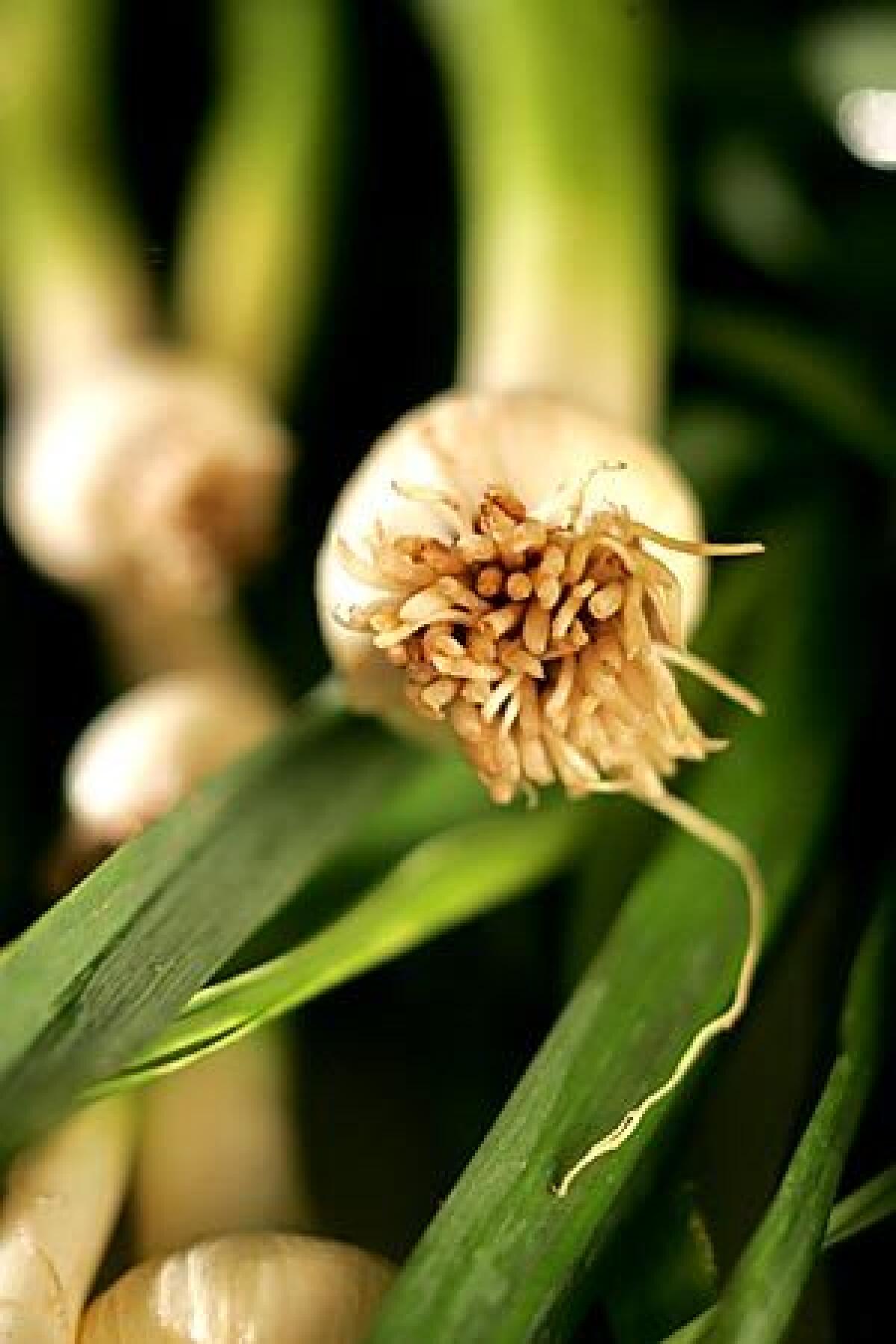Kinder, gentler green garlic mellows out the menu

Long before “Twilight” and “True Blood” and the Modern Age of Vampires, garlic was used as a talisman: a panacea against bad spirits in the Middle Ages and against illness during the Crusades. Even those of us who happily load our soups and stews with dozens of the pale cloves can tell why it was hung across doorways to prevent entrance. Mature garlic can be overwhelming, even relentless; a single raw clove minced on a board is capable of determining the course of an entire meal, whether you want it to or not.
But imagine garlic without its bite, the autocracy of its properties calmed, even made subtle. You don’t need a spell for this one, just a farmer.
Green garlic, also called young garlic, is exactly what it sounds like: the green shoots of immature garlic bulbs that have been picked early. Farmers have historically picked green garlic to thin out their crop, bringing baskets of the early greens to market to sell as a secondary crop, a kind of seasonal teaser for what’s to come. A pile of the delicate stalks discovered on a market stand in the early weeks of spring can seem like a sudden gift, a dirt-clad promise of fava beans and English peas and the approaching burst of full-on spring produce.
But when home cooks and restaurant chefs started grabbing up the piles of green garlic, many farmers turned the accidental crop into a purposeful one, often planting extra rows just for early harvest.
Green garlic, a handful of which resembles a bunch of shapely scallions, is delicate in flavor, with the dominant notes of mature garlic restrained. Imagine the platonic ideal of garlic rather than the squat overlord that usually sits in your dry goods bin.
Unlike full-grown bulbs of garlic — which have been dried and come papered with thin layers of husks, as if they’ve been wrapped in parchment — green garlic can be used in its entirety. The long green stalks, the pale tender bulbs, even the roots can be eaten. Just wash them carefully; as with leeks, another allium, the dirt that engenders the plants can become embedded between the layers as they grow.
Especially if it’s quite young, treat green garlic like you would scallion, mincing the whole stalk and adding it to omelets, stir-fries and soups. It’s even mild enough to add raw to salads. The garlic flavor will be there, but as background music, able to accompany other flavors rather than override them. When cooked, green garlic mellows further, becoming even sweeter and slightly nutty.
Evan Funke, chef de cuisine of Santa Monica’s Rustic Canyon Wine Bar & Seasonal Kitchen, uses the season’s first bunches of green garlic to make soup, loading the broth with it and adding it to the soup’s delicate bread-and-ricotta dumplings.
Funke, who trained in Italy, first sautés the whole green garlic stalks in olive oil and then chops them and mixes them into the dumplings, called strangolapretti, or “priest stranglers,” which he poaches in the garlic soup. Sautéing the garlic in the hot pan not only wilts the stalks but also caramelizes them slightly, bringing out nutty, earthy flavors.
Funke loves the adaptability of green garlic and tries to take advantage of the short time it’s in the markets. Early spring can come in mid-February in Southern California, and green garlic is usually gone by April. Funke puts it into soups like the one with strangolapretti, or pairs it with diver scallops and chickpeas, or makes salsa verde from it. Funke also dredges the carefully washed roots in a little cornstarch and deep-fries them, then adds the fried roots to dishes as an unusual garnish.
Mélisse chef-owner Josiah Citrin, whose restaurant is a few blocks from Rustic Canyon and who, like Funke, shops at the nearby Santa Monica farmers market, likes to use green garlic too. That’s in contrast with mature garlic, which he dislikes so much that when he uses it in his restaurant, he triple-blanches it first. Green garlic is another thing entirely, and Citrin will match it with seafood, making a mousseline out of the greens for his loup de mer.
That you can so easily pair green garlic with delicately flavored fish tells you a lot about the mild beauty of the plant. Sautéed next to a fillet of skin-on wild sockeye salmon in the olive oil that is being used to baste the fish — a technique learned from Providence restaurant’s chef-owner Michael Cimarusti — the green garlic infuses the oil with subtle flavor. Toss into the pan a few blanched fava beans, which hit the early-spring stalls at about the same time as the garlic, and you have a lovely, deeply colorful dish.
Green garlic also suits pasta, particularly whole wheat spaghetti, the nutty flavor of which highlights the mellow garlic. Instead of mincing the garlic, sauté the stalks whole so they intertwine with the pasta when tossed with it in a bowl. Top colorful plates of pasta and green garlic with eggs fried in the garlic-laced oil — and an abundant amount of coarse black pepper and sea salt — and you have a rustic dish that takes only about 15 minutes to make.
Like the early weeks of spring, green garlic is a fleeting pleasure. Although farmers can grow garlic year-round, it’s usually planted in the fall and harvested in late spring, which means that green garlic will appear for a month or two at most in early spring.
Peter Schaner of Schaner Family Farm plants California white garlic and Peruvian pink garlic and pulls the young garlic plants from the fields as early as January and as late as June, however. Crates of young garlic, emerald green and with dirt still clinging to them, were stacked near his market stall on a recent morning in Santa Monica. Schaner doesn’t plant specifically for the green garlic that’s drawing a small crowd of chefs to the back of his truck. “It’s all the same. I just pick it earlier,” he says.
A few stalls down, Barbara Spencer of Windrose Farm brings green garlic from her Paso Robles fields, where she plants a crop expressly to harvest it early. Spencer says they plant small whole bulbs, using up the little bulbs that are too small to sell. Because of the colder climate where she and her husband, Bill, farm, they begin their harvest later than the Schaners do. “Let’s call it March, maybe April,” Spencer says, with the circumspect view of a farmer.
Unlike mature garlic, which requires caution and even avoidance (think full sun and the sign of the cross), green garlic can be used with cheerful abandon. Load your market basket with the stuff, fill your soup pot, decorate the threshold of your kitchen. Green as grass, garlic is an invitation to dinner.
More to Read
Eat your way across L.A.
Get our weekly Tasting Notes newsletter for reviews, news and more.
You may occasionally receive promotional content from the Los Angeles Times.











